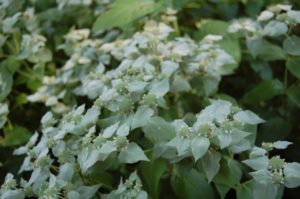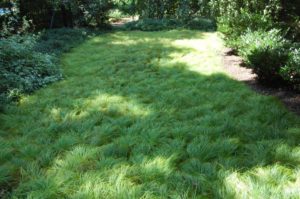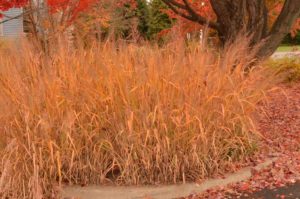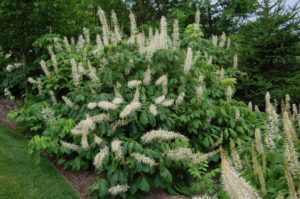Hello Fellow Readers,
I didn’t realize until Bruce Crawford, Director of Rutgers Gardens, emailed the plant list for his recent lecture titled Sexy Native Plants. In the NJ Plants tradeshow held in Edison, NJ, the G-rated version was Native Plants for Native Pollinators. And these babies indeed fit the bill!
We’ve spoken about layers of plants found in nature and well-designed gardens; and how the groundcover layer can be an ecological as well as a beautiful alternative to mulching. Bruce touts the weed-free benefits of Mountain Mint (Pycnanthemum muticum), which spreads ambitiously by rhizomes (underground stems) without being invasive. With blue-green fuzzy leaves, it creates a silvery 2 to 3-foot-tall blanket in the sun or shade that tolerates dryness, though it prefers to be moist. Pollinators love its pinkish-white flowers in late summer.
How about a hands-free groundcover such as Pennsylvania sedge (Carex pennsylvanicum). “No cutting, no weeding, no watering,” boasts Bruce, “and, you can walk on it.” It’s best in full shade and can endure wetness for a while but prefers to be dry. This grass-like beauty is 14 inches tall but lays in soft waves about 8 inches high. It grows fine under trees and makes a perfect lawn alternative in dry shady areas.
Then there’s Prairie Dock (Silphium terebinthinaceum) with its long, almost leafless flower stems leading to three-inch sunflower-like blooms in summer. The flower stems rise seven feet above the 2-foot-high foliage, which “looks great with tall grasses in full sun,” flaunts Bruce, who adores this plant. Speaking of tall grasses, there’s Switchgrass ‘Dallas Blues’ (Panicum virgatum) standing 6 to 8 feet, like full sun, but can accept a bit of shade. Unfortunately, it loses its blueness when it flowers pinkish spikes. However, come Fall, the outstanding burnt yellow color is worth the wait.
The flower of Swamp Sunflower (Helianthus angustifolius) looks much like black-eyed Susan (pictured in the banner photo above). She’s a prolific bloomer in the fall until frost. She may indeed need staking, but given full sun and plenty of moisture, she’s sure to stand tall at about 6 feet.
I was thrilled to hear Bruce’s accolades for my favorite large woody shrub Bottlebrush Buckeye (Aesculus parviflora var. serotina) though I had not known this variety. Serotina grows more significant to 20 feet, and the bottlebrush-like blooms appear about August – three weeks later than the species.
The fantastic thing about these Sexy Natives is they’re deer resistant, and I assure you they’re G-rated—G for glorious and good for pollinators.
Garden Dilemmas? Askmarystone@gmail.com
Rutgers Gardens, located on the Rutgers University campus in New Brunswick, NJ, is a public botanical garden free to visitors and open all year round.

Panicum virgatum ‘Dallas Blues’ with Hydrangea paniculata ‘Limelight’ at Cascades Hotel in Hamburg, NJ
Defining “Native Plants”: In the lecture handout Bruce Crawford, Director of Rutgers Gardens, shared his philosophy on the definition of native plants, which can be confusing. “Is it a plant naturally growing only in your county, your state, or your regional portion of the country?” Bruce feels “a garden is an art form created by human hands” (I love that philosophy!). Bruce says, “Cultivars, which are either created or reproduced through human hands, are therefore acceptable. In a wild or totally naturalistic environment, I prefer and appreciate the broad diversity found within seedling-produced plants; the diversity of form, disease resistance, and appeal to pollinators is a valid concern.”







